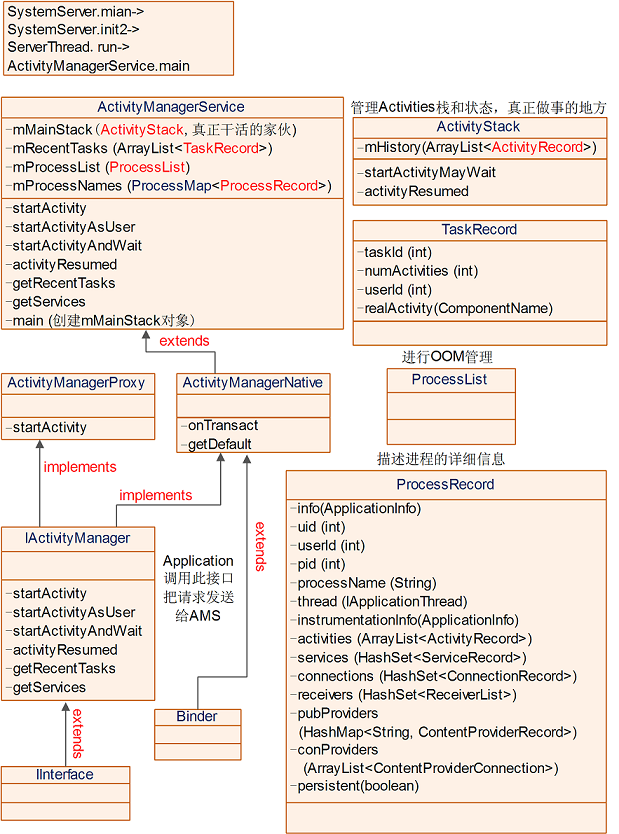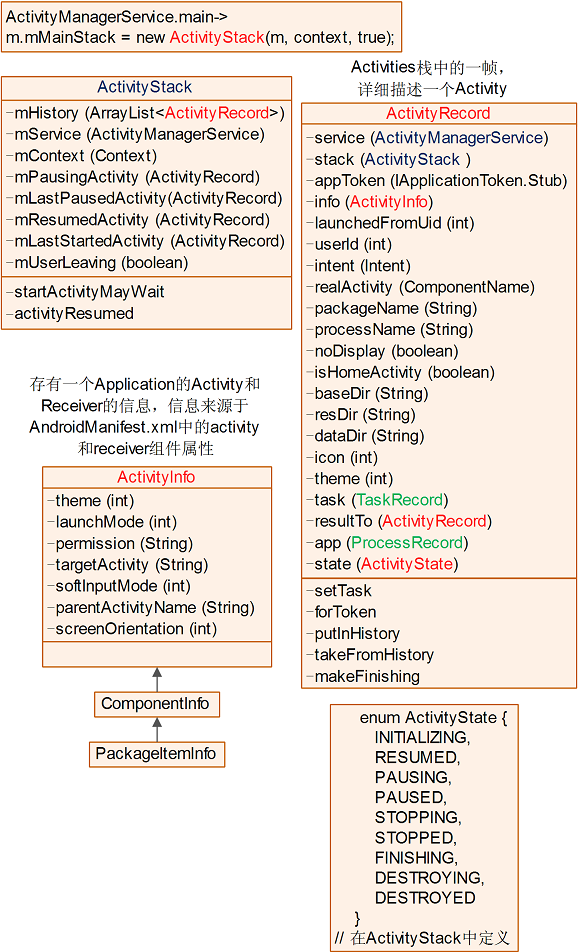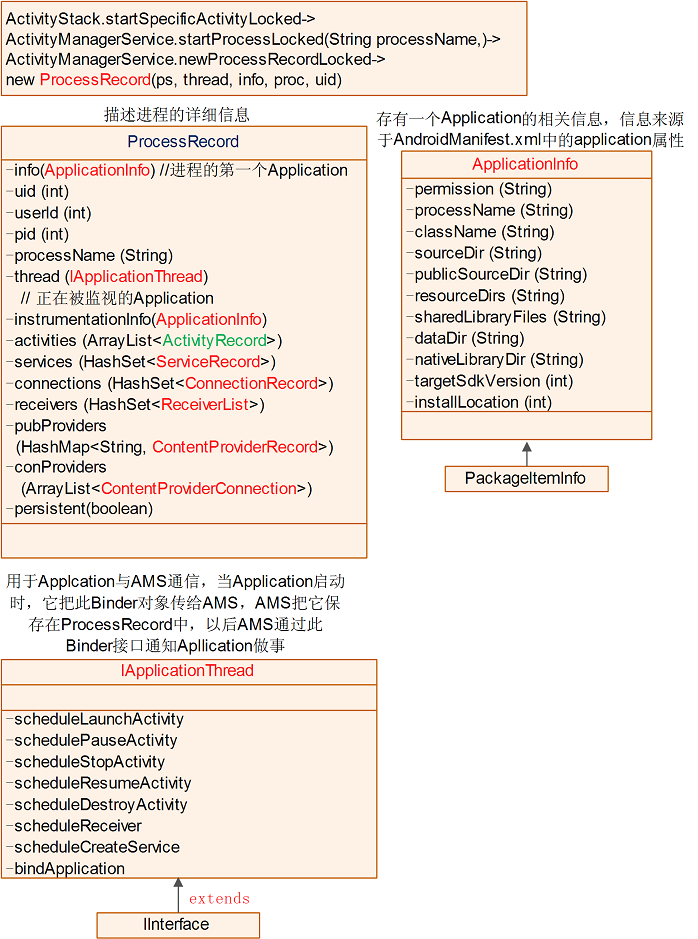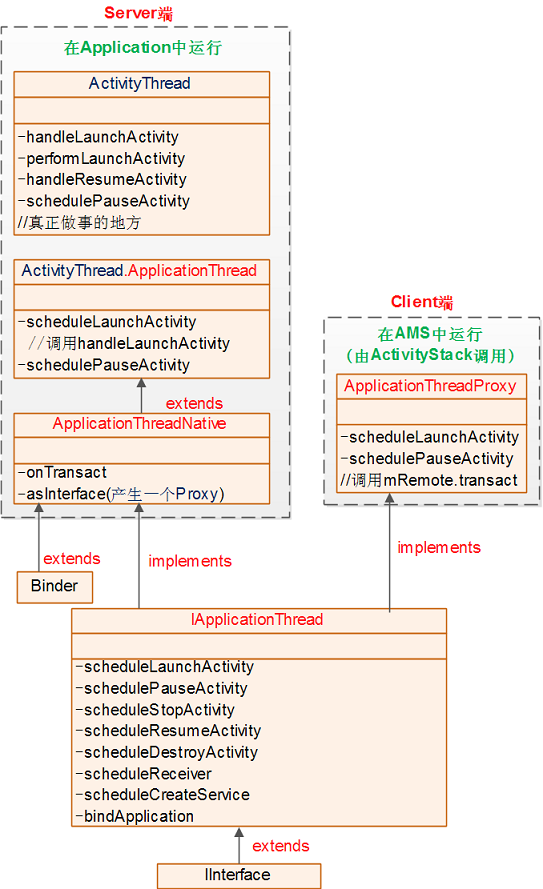1. 基本概念
1.1 Instrumentation是什么?
顾名思义,仪器仪表,用于在应用程序中进行“测量”和“管理”工作。一个应用程序中只有一个Instrumentation实例对象,且每个Activity都有此对象的引用。Instrumentation将在任何应用程序运行前初始化,可以通过它监测系统与应用程序之间的所有交互,即类似于在系统与应用程序之间安装了个“窃听器”。
当ActivityThread 创建(callActivityOnCreate)、暂停、恢复某个Activity时,通过调用此对象的方法来实现,如:
1) 创建: callActivityOnCreate
2) 暂停: callActivityOnPause
3) 恢复: callActivityOnResume
Instrumentation和ActivityThread的关系,类似于老板与经理的关系,老板负责对外交流(如与Activity Manager Service),Instrumentation负责管理并完成老板交待的任务。
它通过以下两个成员变量来对当前应用进程中的Activity进行管理:
private List<ActivityWaiter> mWaitingActivities;
private List<ActivityMonitor> mActivityMonitors;
其功能函数下表所示:
| 功能 | 函数 |
| 增加删除Monitor | addMonitor(ActivityMonitor monitor) removeMonitor(ActivityMonitor monitor) |
| Application与Activity生命周期控制 | newApplication(Class<?> clazz, Context context) newActivity(ClassLoader cl, String className,Intent intent) callActivityOnCreate(Activity activity, Bundle icicle) callActivityOnDestroy(Activity activity) callActivityOnStart(Activity activity) callActivityOnRestart(Activity activity) callActivityOnResume(Activity activity) callActivityOnStop(Activity activity) callActivityOnPause(Activity activity) |
| Instrumentation生命周期控制 | onCreate(Bundle arguments) start() onStart() finish(int resultCode, Bundle results) onDestroy() |
| 发送用户操控信息到当前窗口 | sendCharacterSync(int keyCode) sendPointerSync(MotionEvent event) sendTrackballEventSync(MotionEvent event) sendTrackballEventSync(MotionEvent event) |
| 同步操作 | startActivitySync(Intent intent) //它调用Context.startActivity runOnMainSync(Runnable runner) waitForIdle() |
2. Android应用程序启动过程(MainActivity)
即MainActivity的启动过程,在此过程中,将创建一个新的进程来执行此MainActivity。
Android应用程序从Launcher启动流程如下所示:
/*****************************************************************
* Launcher通过Binder告诉ActivityManagerService,
* 它将要启动一个新的Activity;
****************************************************************/
Launcher.startActivitySafely->
Launcher.startActivity->
//要求在新的Task中启动此Activity
//intent.addFlags(Intent.FLAG_ACTIVITY_NEW_TASK)
Activity.startActivity->
Activity.startActivityForResult->
Instrumentation.execStartActivity->
// ActivityManagerNative.getDefault()返回AMS Proxy接口
ActivityManagerNative.getDefault().startActivity->
ActivityManagerProxy.startActivity->
ActivityManagerService.startActivity-> (AMS)
ActivityManagerService.startActivityAsUser->
ActivityStack.startActivityMayWait->
ActivityStack.resolveActivity(获取ActivityInfo)
//aInfo.name为main Activity,如:com.my.test.MainActivity
//aInfo.applicationInfo.packageName为包名,如com.my.test
ActivityStack.startActivityLocked->
//ProcessRecord callerApp; 调用者即Launcher信息
//ActivityRecord sourceRecord; Launcher Activity相关信息
//ActivityRecord r=new ActivityRecord(...),将要创建的Activity相关信息
ActivityStack.startActivityUncheckedLocked->
//Activity启动方式:ActivityInfo.LAUNCH_MULTIPLE/LAUNCH_SINGLE_INSTANCE/
// ActivityInfo.LAUNCH_SINGLE_TASK/LAUNCH_SINGLE_TOP)
// 创建一个新的task,即TaskRecord,并保存在ActivityRecord.task中
//r.setTask(new TaskRecord(mService.mCurTask, r.info, intent), null, true)
// 把新创建的Activity放在栈顶
ActivityStack.startActivityLocked->
ActivityStack.resumeTopActivityLocked->
ActivityStack.startPausingLocked (使Launcher进入Paused状态)->
/*****************************************************************
* AMS通过Binder通知Launcher进入Paused状态
****************************************************************/
ApplicationThreadProxy.schedulePauseActivity->
//private class ApplicationThread extends ApplicationThreadNative
ApplicationThread.schedulePauseActivity->
ActivityThread.queueOrSendMessage->
// 调用Activity.onUserLeaveHint
// 调用Activity.onPause
// 通知activity manager我进入了pause状态
ActivityThread.handlePauseActivity->
/*****************************************************************
* Launcher通过Binder告诉AMS,它已经进入Paused状态
****************************************************************/
ActivityManagerProxy.activityPaused->
ActivityManagerService.activityPaused->
ActivityStack.activityPaused->(把Activity状态修改为PAUSED)
ActivityStack.completePauseLocked->
// 参数为代表Launcher这个Activity的ActivityRecord
// 使用栈顶的Activity进入RESUME状态
ActivityStack.resumeTopActivityLokced->
//topRunningActivityLocked将刚创建的放于栈顶的activity取回来
// 即在ActivityStack.startActivityUncheckedLocked中创建的
/*****************************************************************
* AMS创建一个新的进程,用来启动一个ActivityThread实例,
* 即将要启动的Activity就是在这个ActivityThread实例中运行
****************************************************************/
ActivityStack.startSpecificActivityLocked->
// 创建对应的ProcessRecord
ActivityManagerService.startProcessLocked->
// 启动一个新的进程
// 新的进程会导入android.app.ActivityThread类,并且执行它的main函数,
// 即实例化ActivityThread, 每个应用有且仅有一个ActivityThread实例
Process.start("android.app.ActivityThread",...)->
// 通过zygote机制创建一个新的进程
Process.startViaZygote->
// 这个函数在进程中创建一个ActivityThread实例,然后调用
// 它的attach函数,接着就进入消息循环
ActivityThread.main->
/*****************************************************************
* ActivityThread通过Binder将一个ApplicationThread类的Binder对象
* 传递给AMS,以便AMS通过此Binder对象来控制Activity整个生命周期
****************************************************************/
ActivityThread.attach->
IActivityManager.attachApplication(mAppThread)->
ActivityManagerProxy.attachApplication->
ActivityManagerService.attachApplication->
// 把在ActivityManagerService.startProcessLocked中创建的ProcessRecord取出来
ActivityManagerService.attachApplicationLocked->
/*****************************************************************
* AMS通过Binder通知ActivityThread一切准备OK,它可以真正启动新的Activity了
****************************************************************/
// 真正启动Activity
ActivityStack.realStartActivityLocked->
ApplicationThreadProxy.scheduleLaunchActivity->
ApplicationThread.scheduleLaunchActivity->
ActivityThread.handleLaunchActivity->
// 加载新的Activity类,并执行它的onCreate
ActivityThread.performLaunchActivity
/*1) Instrumentation.newActivity: 加载新类,即创建Activity对象;
2) ActivityClientRecord.packageInfo.makeApplication:创建Application对象;
<LoadedApk.makeApplication>
3) Activity.attach(Context context, ActivityThread aThread,
Instrumentation instr, IBinder token, int ident,
Application application, Intent intent, ActivityInfo info,
CharSequence title, Activity parent, String id,
NonConfigurationInstances lastNonConfigurationInstances,
Configuration config):把Application attach到Activity, 即把Activtiy
相关信息设置到新创建的Activity中
4) Instrumentation.callActivityOnCreate:调用onCreate;*/
// 使用Activity进入RESUMED状态,并调用onResume
ActivityThread.handleResumeActivity
3. ActivityManagerService
3.1 类中关键信息
public final class ActivityManagerService extends ActivityManagerNative
implements Watchdog.Monitor, BatteryStatsImpl.BatteryCallback {
...
// Maximum number of recent tasks that we can remember.
static final int MAX_RECENT_TASKS = 20;
public ActivityStack mMainStack; // 管理Activity堆栈
// Whether we should show our dialogs (ANR, crash, etc) or just perform their
// default actuion automatically. Important for devices without direct input
// devices.
private boolean mShowDialogs = true;
/**
* Description of a request to start a new activity, which has been held
* due to app switches being disabled.
*/
static class PendingActivityLaunch {
ActivityRecord r;
ActivityRecord sourceRecord;
int startFlags;
}
/**
* Activity we have told the window manager to have key focus.
*/
ActivityRecord mFocusedActivity = null;
/**
* List of intents that were used to start the most recent tasks.
*/
final ArrayList<TaskRecord> mRecentTasks = new ArrayList<TaskRecord>();
/**
* Process management.
*/
final ProcessList mProcessList = new ProcessList();
/**
* All of the applications we currently have running organized by name.
* The keys are strings of the application package name (as
* returned by the package manager), and the keys are ApplicationRecord
* objects.
*/
final ProcessMap<ProcessRecord> mProcessNames = new ProcessMap<ProcessRecord>();
/**
* The currently running isolated processes.
*/
final SparseArray<ProcessRecord> mIsolatedProcesses = new SparseArray<ProcessRecord>();
...
public static final Context main(int factoryTest) { //main入口函数
AThread thr = new AThread();
thr.start();
synchronized (thr) {
while (thr.mService == null) {
try {
thr.wait();
} catch (InterruptedException e) {
}
}
}
ActivityManagerService m = thr.mService;
mSelf = m;
ActivityThread at = ActivityThread.systemMain();
mSystemThread = at;
Context context = at.getSystemContext();
context.setTheme(android.R.style.Theme_Holo);
m.mContext = context;
m.mFactoryTest = factoryTest;
m.mMainStack = new ActivityStack(m, context, true); // 创建ActivityStack
m.mBatteryStatsService.publish(context);
m.mUsageStatsService.publish(context);
synchronized (thr) {
thr.mReady = true;
thr.notifyAll();
}
m.startRunning(null, null, null, null);
return context;
}
}
3.2 家族图谱

4. ActivityStack-真正做事的家伙
ActivityManagerService使用它来管理系统中所有的Activities的状态,Activities使用stack的方式进行管理。它是真正负责做事的家伙,很勤快的,但外界无人知道!
4.1 类中关键信息
/**
* State and management of a single stack of activities.
*/
final class ActivityStack {
final ActivityManagerService mService;
final boolean mMainStack;
final Context mContext;
enum ActivityState {
INITIALIZING,
RESUMED,
PAUSING,
PAUSED,
STOPPING,
STOPPED,
FINISHING,
DESTROYING,
DESTROYED
}
/**
* The back history of all previous (and possibly still
* running) activities. It contains HistoryRecord objects.
*/
final ArrayList<ActivityRecord> mHistory = new ArrayList<ActivityRecord>();
/**
* Used for validating app tokens with window manager.
*/
final ArrayList<IBinder> mValidateAppTokens = new ArrayList<IBinder>();
/**
* List of running activities, sorted by recent usage.
* The first entry in the list is the least recently used.
* It contains HistoryRecord objects.
*/
final ArrayList<ActivityRecord> mLRUActivities = new ArrayList<ActivityRecord>();
/**
* List of activities that are waiting for a new activity
* to become visible before completing whatever operation they are
* supposed to do.
*/
final ArrayList<ActivityRecord> mWaitingVisibleActivities
= new ArrayList<ActivityRecord>();
/**
* List of activities that are ready to be stopped, but waiting
* for the next activity to settle down before doing so. It contains
* HistoryRecord objects.
*/
final ArrayList<ActivityRecord> mStoppingActivities
= new ArrayList<ActivityRecord>();
/**
* List of activities that are in the process of going to sleep.
*/
final ArrayList<ActivityRecord> mGoingToSleepActivities
= new ArrayList<ActivityRecord>();
/**
* When we are in the process of pausing an activity, before starting the
* next one, this variable holds the activity that is currently being paused.
*/
ActivityRecord mPausingActivity = null;
/**
* This is the last activity that we put into the paused state. This is
* used to determine if we need to do an activity transition while sleeping,
* when we normally hold the top activity paused.
*/
ActivityRecord mLastPausedActivity = null;
/**
* Current activity that is resumed, or null if there is none.
*/
ActivityRecord mResumedActivity = null;
/**
* This is the last activity that has been started. It is only used to
* identify when multiple activities are started at once so that the user
* can be warned they may not be in the activity they think they are.
*/
ActivityRecord mLastStartedActivity = null;
/**
* Set to indicate whether to issue an onUserLeaving callback when a
* newly launched activity is being brought in front of us.
*/
boolean mUserLeaving = false;
ActivityStack(ActivityManagerService service, Context context, boolean mainStack) {
mService = service;
mContext = context;
mMainStack = mainStack;
...
}
...
}
4.2 家族图谱

5. ProcessRecord
记录了一个进程的相关信息。
5.1 类中关键信息
/**
* Full information about a particular process that
* is currently running.
*/
class ProcessRecord {
final ApplicationInfo info; // all about the first app in the process
final boolean isolated; // true if this is a special isolated process
final int uid; // uid of process; may be different from "info" if isolated
final int userId; // user of process.
final String processName; // name of the process
IApplicationThread thread; // the actual proc... may be null only if
// "persistent" is true (in which case we
// are in the process of launching the app)
// 是ApplicationThread对象的远程接口,
// 通过此接口通知Activity进入对应的状态
int pid; // The process of this application; 0 if none
ApplicationInfo instrumentationInfo; // the application being instrumented
BroadcastRecord curReceiver;// receiver currently running in the app
// contains HistoryRecord objects
final ArrayList<ActivityRecord> activities = new ArrayList<ActivityRecord>();
// all ServiceRecord running in this process
final HashSet<ServiceRecord> services = new HashSet<ServiceRecord>();
// services that are currently executing code (need to remain foreground).
final HashSet<ServiceRecord> executingServices
= new HashSet<ServiceRecord>();
// All ConnectionRecord this process holds
final HashSet<ConnectionRecord> connections
= new HashSet<ConnectionRecord>();
// all IIntentReceivers that are registered from this process.
final HashSet<ReceiverList> receivers = new HashSet<ReceiverList>();
// class (String) -> ContentProviderRecord
final HashMap<String, ContentProviderRecord> pubProviders
= new HashMap<String, ContentProviderRecord>();
// All ContentProviderRecord process is using
final ArrayList<ContentProviderConnection> conProviders
= new ArrayList<ContentProviderConnection>();
boolean persistent; // always keep this application running?
boolean crashing; // are we in the process of crashing?
Dialog crashDialog; // dialog being displayed due to crash.
boolean notResponding; // does the app have a not responding dialog?
Dialog anrDialog; // dialog being displayed due to app not resp.
boolean removed; // has app package been removed from device?
boolean debugging; // was app launched for debugging?
boolean waitedForDebugger; // has process show wait for debugger dialog?
Dialog waitDialog; // current wait for debugger dialog
ProcessRecord(BatteryStatsImpl.Uid.Proc _batteryStats, IApplicationThread _thread,
ApplicationInfo _info, String _processName, int _uid) {
batteryStats = _batteryStats;
info = _info;
isolated = _info.uid != _uid;
uid = _uid;
userId = UserHandle.getUserId(_uid);
processName = _processName;
pkgList.add(_info.packageName);
thread = _thread;
maxAdj = ProcessList.HIDDEN_APP_MAX_ADJ;
hiddenAdj = clientHiddenAdj = emptyAdj = ProcessList.HIDDEN_APP_MIN_ADJ;
curRawAdj = setRawAdj = -100;
curAdj = setAdj = -100;
persistent = false;
removed = false;
}
...
}
5. 2 家族图谱

6. IApplicationThread接口AMS->Application
IApplicationThread为AMS作为客户端访问Application服务器端的Binder接口。当创建Application时,将把此Binder对象传递给AMS,然后AMS把它保存在mProcessNames.ProcessRecord.thread中。当需要通知Application工作时,则调用IApplicationThread中对应的接口函数。
其相互关系如下图所示:


